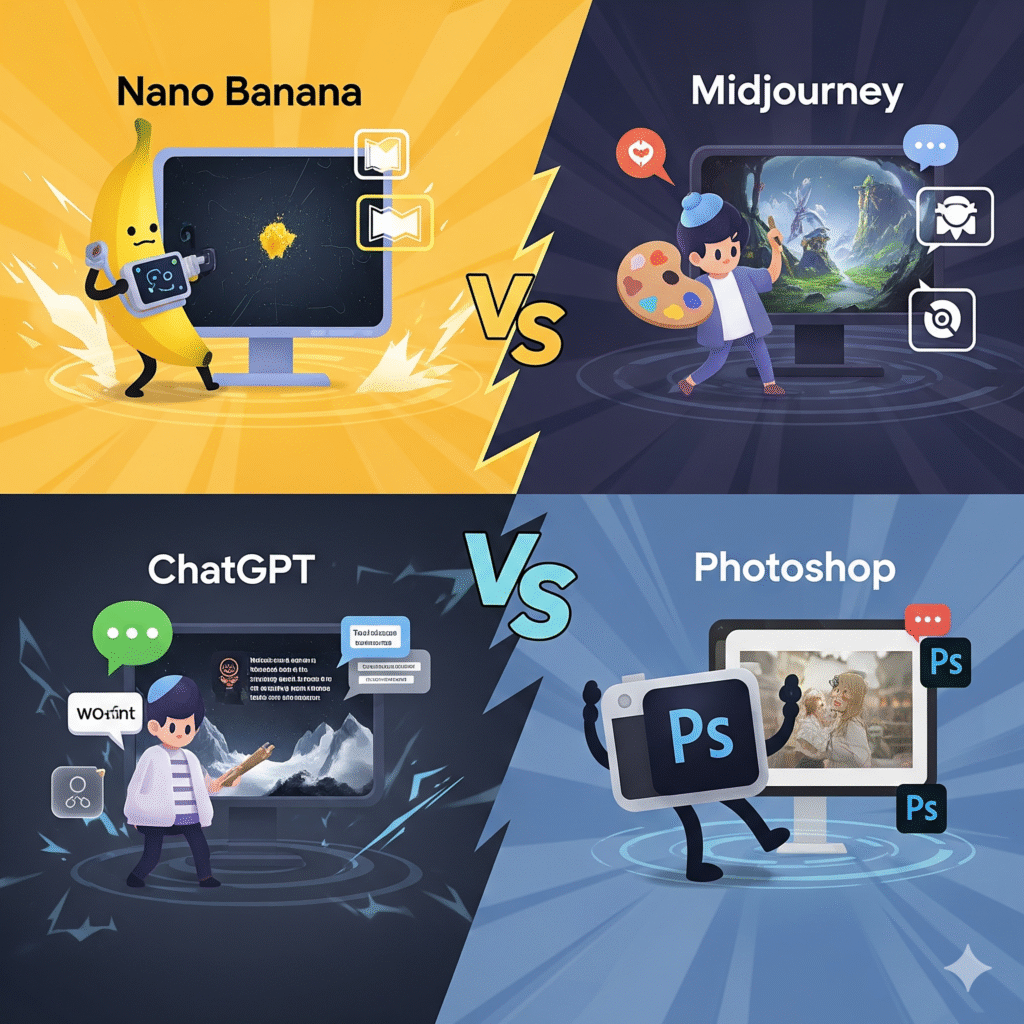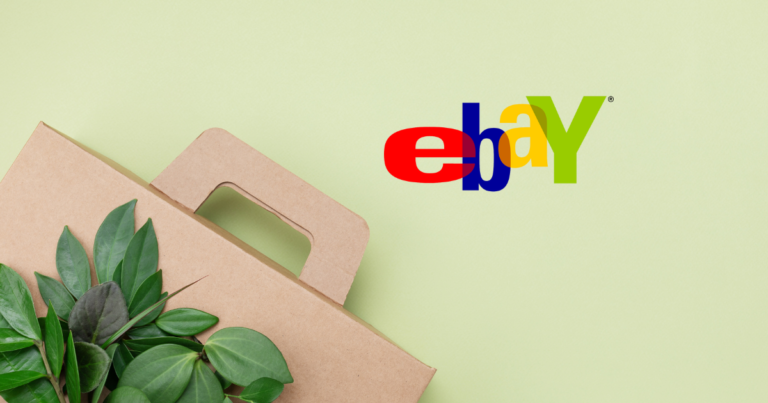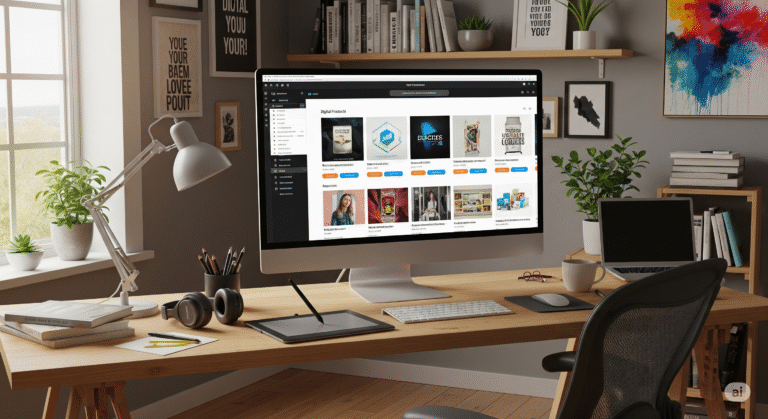The Ultimate Showdown in 2025: Is Google’s “Nano Banana” the New King of AI Image Editing?
Table of Contents
Remember the frustration of a creative vision blocked by a blank digital canvas? Perhaps you’ve spent endless hours meticulously editing product shots, striving for the perfect background, or trying to create a social media post with a consistent character. The process often felt like a chore, a complicated hurdle rather than a creative outlet. You’ve likely wished for a simpler way, a tool that could bridge the gap between your imagination and the final output. Now, a new contender has emerged with a playful codename and a serious promise: Google’s “Nano Banana.” But in a world already saturated with powerful AI tools, can this newcomer truly simplify the creative process and stand its ground against the established giants like Midjourney, ChatGPT, and Adobe Photoshop? This article will unpack the hype and give you the clear, unbiased comparison you need to decide which tool is the right fit for your unique needs.
The Contenders: A Quick Introduction to the AI Image Titans
Before we get to the main event, let’s introduce the four major players in this digital duel. Each of these tools brings a different set of strengths to the table, and understanding their core purpose is the first step toward figuring out which one belongs in your toolkit.
- Google “Nano Banana” (Gemini 2.5 Flash Image): This is Google’s newest AI image editor, celebrated for its unique ability to maintain character consistency and perform precise, natural language-based edits. It’s designed for simplicity and speed.
- Midjourney: Often hailed as the master of text-to-image generation, this tool is known for its ability to create stunning, high-quality artistic visuals and distinctive styles from a simple text prompt.
- ChatGPT (with DALL-E 3): OpenAI’s versatile language model seamlessly integrates powerful image generation. It’s an excellent all-in-one solution for those who want a conversational, creative tool.
- Adobe Photoshop: The industry-standard professional image editing software. It offers unparalleled control and a massive feature set for a manual workflow, making it the go-to for professionals who require meticulous precision.
The Head-to-Head Comparison: Features and Core Strengths
When you’re choosing a tool, you need to know what it’s best at. Let’s pit these four against each other to see how they perform on a feature-by-feature basis, focusing on two key areas: image editing and AI generation.
Image Editing Capabilities: Who Can Manipulate Photos with the Most Precision?
Your ability to edit and alter existing images is a critical factor. Each tool approaches this task differently, and knowing these differences will help you choose the right one for your specific projects.
- Google “Nano Banana”: This is where the “nano banana” truly shines. Its key strength is its incredible ability to maintain character and object consistency. Imagine you have a photo of a person and you want to change their outfit while keeping their face, expression, and posture exactly the same. “Nano Banana” excels at this. You simply tell it what you want to do in plain English, and it executes the edit with remarkable precision. It’s also excellent for seamless background replacement and targeted in-painting—filling in a specific area of an image based on your prompt.
- Midjourney: While Midjourney is a generation powerhouse, its editing features, like in-painting and out-painting, are more focused on artistic transformation. You can add new elements or expand the borders of an image, but it’s not as tailored for subtle, character-specific edits. You’re more likely to use it for an artistic change, like adding wings to a character, rather than a realistic, minor adjustment.
- ChatGPT (with DALL-E 3): This tool offers a highly conversational approach to editing. You can simply chat with it and tell it what changes you want to make. It does a decent job with in-painting and out-painting, but the results can sometimes alter the entire image’s style or composition. For fine-grained consistency, you may find yourself re-prompting multiple times to get the exact result you’re looking for.
- Adobe Photoshop: This is the king of manual control. With Photoshop, you have unrivaled, pixel-level precision. You can use advanced masking, layer management, and a vast array of filters to make any change you want, no matter how small. The trade-off is that this precision requires significant skill and time. Photoshop’s recent integration of AI features like Generative Fill is a powerful addition, but it’s still part of a larger, manual workflow.

AI Generation Prowess: From Prompt to Picture
When you’re starting with a blank canvas, your choice of tool can define the final product. Here’s how they stack up in the world of pure creation.
- Midjourney: If your goal is to create a masterpiece from scratch, Midjourney is the top choice. It is the undisputed leader in artistic generation, known for its aesthetic quality, unique styles, and photorealistic capabilities. The images it produces often have a cinematic, high-quality look that’s difficult to replicate.
- Google “Nano Banana”: This tool’s generation capabilities are strong, particularly for creating a series of images with a consistent subject. This is a game-changer for storytelling and branding. Imagine you need to create ten different images for a marketing campaign, each featuring the same character in a different scenario. The “nano banana” can handle this with impressive accuracy, ensuring visual continuity.
- ChatGPT (with DALL-E 3): DALL-E 3 is excellent at understanding complex, layered prompts. Its strength lies in its ability to follow instructions and generate a wide range of styles, from realistic to cartoonish. It’s a great all-around generator, especially for users who appreciate a familiar chat-based interface.
- Adobe Photoshop: Photoshop’s AI generation is integrated into its editing workflow. Its Generative Fill feature is brilliant for augmenting existing photos or filling in gaps seamlessly. It’s not a standalone text-to-image generator in the same vein as the others, but it’s an incredibly powerful hybrid tool.
User Experience and Accessibility: Which Tool is Easiest to Use?
Your time is valuable. A tool that is easy to learn and use can save you countless hours.
- Google “Nano Banana”: This tool has an extremely low barrier to entry. The user interface is simple and conversational. If you can type a prompt, you can use it. It’s integrated directly into the Gemini app, making it incredibly accessible for anyone who already uses Google’s services. The learning curve is minimal.
- Midjourney: Midjourney’s primary interface is a Discord server, which can be non-intuitive for new users. While a web interface is available, you still need to learn a specific syntax for prompting to get the best results. The learning curve is moderate, and mastering the commands can take some time.
- ChatGPT (with DALL-E 3): With its familiar chat interface, this tool is very accessible. If you’ve ever used ChatGPT, you’ll feel right at home. It’s easy to use for quick, on-the-fly image generation and editing. The learning curve is minimal, though, like Midjourney, better results come from well-crafted prompts.
- Adobe Photoshop: This is a professional-grade tool with a complex user interface. It has hundreds of tools, menus, and panels. It requires a powerful computer and a significant time investment to master. The learning curve is steep, and most professionals spend years refining their skills with this software.
Pricing and Monetization: The Cost of Creativity
Your budget is a factor, and the pricing models of these tools vary significantly.
- Google “Nano Banana”: As of now, the “nano banana” feature is available for free within the Gemini app. This is a major competitive advantage, especially for casual users and small businesses who may not have the budget for a subscription.
- Midjourney: Midjourney operates on a subscription-based model. It offers various tiers depending on your usage, making it an investment geared towards power users and professionals who rely on it for their work.
- ChatGPT (with DALL-E 3): This tool is part of the ChatGPT Plus subscription. The value is in the entire AI suite, not just the image tool. The cost is a monthly fee that gives you access to a comprehensive set of AI features.
- Adobe Photoshop: Photoshop is a professional tool with a professional price tag. It’s subscription-based through Adobe Creative Cloud, and it’s often bundled with other Adobe apps, making it a comprehensive but costly solution.
Use Cases: Who Should Use Which Tool?
Now that we’ve broken down the features, pricing, and user experience, let’s talk about who should use each tool for specific tasks.
- Google “Nano Banana”: This tool is your best bet if you are a social media manager, a small business owner, or a casual user needing quick, consistent edits or mockups. It’s perfect for creating a series of marketing images with a consistent brand character, quickly swapping outfits on a model for an e-commerce site, or making minor edits to personal vacation photos without a lot of hassle.
- Midjourney: You should choose Midjourney if you are an artist, a designer, a concept creator, or a hobbyist. Use it when you need to generate unique artwork, create a visual mood board for a project, or design a brand logo with a distinct artistic flair.
- ChatGPT (with DALL-E 3): This is a great tool for marketers, writers, and anyone who needs a versatile solution for both text and image tasks. You can use it to generate an article illustration based on a prompt, create quick visual aids for a presentation, or brainstorm creative ideas with a visual component.
- Adobe Photoshop: This is your only choice if you are a professional photographer, a graphic designer, a digital artist, or a retoucher. It’s a tool for high-end photo retouching, creating complex digital compositions, or preparing files for print design.
Conclusion: The Verdict on “Nano Banana”
In this ultimate showdown, a clear picture emerges. While Photoshop remains the uncontested king of professional control and Midjourney dominates the realm of artistic generation, Google’s “Nano Banana” carves out a powerful and accessible new niche. It’s not about replacing the old guard, but about democratizing advanced image editing for everyone. Its unparalleled character consistency and intuitive, natural language interface make it an invaluable tool for creators who need speed and consistency without the steep learning curve.
The era of wrestling with complicated software for simple edits is over. The “nano banana” is a game-changer for daily, practical creative tasks, and its free availability makes it a tool that you can, and should, start using today. It’s a powerful new option that gives you a level of creative control that was once reserved for professionals, but now, it’s right at your fingertips.
Frequently Asked Questions about the “Nano Banana”
- Q: Is Google’s “Nano Banana” really free to use?
- A: Yes, the “nano banana” feature is currently available for free to all Gemini users.
- Q: How does the “Nano Banana” maintain character consistency?
- A: The model is specifically trained to recognize and maintain the key features of a subject, such as a face or a pet, across multiple prompts and edits. This capability is a core feature that sets the “nano banana” apart from other AI image tools.
- Q: Can “Nano Banana” replace professional graphic designers?
- A: For complex, high-stakes creative work, professional designers and their expertise with tools like Photoshop are still essential. However, the “nano banana” can significantly streamline and automate many day-to-day creative tasks, allowing designers to focus on more strategic work.
- Q: What are the main limitations of the “Nano Banana” tool?
- A: While a powerful editor, the “nano banana” can still struggle with very intricate text placement and may sometimes introduce subtle artifacts in highly complex images. It also does not offer the same level of granular control as Photoshop.







